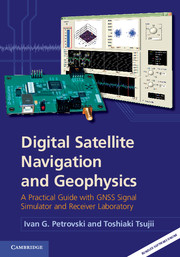 Digital Satellite Navigation and Geophysics
Digital Satellite Navigation and Geophysics Book contents
- Frontmatter
- Contents
- Foreword
- Preface
- 1 Methods of positioning with navigation satellites
- 2 Presentations and applications of GNSS orbits
- 3 GNSS signal generation in transmitters and simulators
- 4 Signal propagation throughthe atmosphere
- 5 Receiver RF front end
- 6 Real-time baseband processor on a PC
- 7 Multipath
- 8 Optimization of GNSS observables
- 9 Using observables in navigation-related tasks
- 10 Electromagnetic scintillation of GNSS signal
- 11 Geophysical measurements using GNSS signals
- 12 Aiding baseband and navigation processors using INS
- Next step – RF lab
- Index
- References
3 - GNSS signal generation in transmitters and simulators
Published online by Cambridge University Press: 05 March 2012
- Frontmatter
- Contents
- Foreword
- Preface
- 1 Methods of positioning with navigation satellites
- 2 Presentations and applications of GNSS orbits
- 3 GNSS signal generation in transmitters and simulators
- 4 Signal propagation throughthe atmosphere
- 5 Receiver RF front end
- 6 Real-time baseband processor on a PC
- 7 Multipath
- 8 Optimization of GNSS observables
- 9 Using observables in navigation-related tasks
- 10 Electromagnetic scintillation of GNSS signal
- 11 Geophysical measurements using GNSS signals
- 12 Aiding baseband and navigation processors using INS
- Next step – RF lab
- Index
- References
Summary
In this chapter we examine how GNSS signals are created. We mostly concentrate our presentation on the signals of currently operating GPS and GLONASS. We also consider the main specific features of future GNSS signals including modernized GPS, modernized GLONASS, and GALILEO. We also describe in this chapter how GNSS signals are generated in simulators and how those signals differ from the signals generated by satellite transmitters and pseudolites. The particular place which this chapter occupies in the book is schematically depicted on Figure 3.1. In this book we describe GNSS using some help from a GNSS signal simulator. GNSS simulation today has become an important and significant part of the GNSS technology, which enjoys a high demand. Further, any presentation is based on models. These models can be mathematical, empirical, or speculative. A simulator-based model provides one with the best combination of those models, being as close to the real system from a receiver point of view as possible.
Spread-spectrum concept and benefits
The spread-spectrum concept lies at the core of all GNSS signals. As described in the previous chapter, GNSS satellites are located on medium Earth orbits (MEO) at a distance of about 20 000 km from the user receiver. Even spaceborne receivers located on low Earth orbit (LEO) spacecraft are almost at the same distance to GNSS satellites as a user on the surface of the Earth. Signal energy decreases inversely as the square of distance between signal source and a receiver. We have already encountered the inverse square law in relation to gravitational forces. The signal power as well as gravitational force follows an inverse square law because energy is equally spread on the spherical surface at the receiver distance. Satellite payload should be minimized in order to make its delivery to an orbit cheaper, and the transmission energy also should be minimized in order for a transmitter to consume less energy. As a result of these constraints, the satellite signal is not very powerful, and when it reaches the Earth it is well below noise level. The GNSS signal power levels are given in Table 3.1 based on GPS ICD for L1/L2/L2C signals [1], GPS L5 ICD [2], GPS L1C ICD [3], GLONASS ICD [4] , GALILEO ICD [5], and QZSS ICD [6].
Information
- Type
- Chapter
- Information
- Digital Satellite Navigation and GeophysicsA Practical Guide with GNSS Signal Simulator and Receiver Laboratory, pp. 67 - 103Publisher: Cambridge University PressPrint publication year: 2012